Chinese Australians
Chinese Australians (simplified Chinese: 华裔澳洲人 or 华裔澳大利亚人; traditional Chinese: 華裔澳洲人 or 華裔澳大利亞人; pinyin: Huáyì àozhōu rén or Huáyì àodàlìyà rén) are Australian citizens of Chinese ancestry. Chinese Australians are one of the largest groups of Overseas Chinese people, forming the largest Overseas Chinese community in Oceania. Per capita, Australia has more people of Chinese ancestry than any country outside Asia. Many Chinese Australians have immigrated from Mainland China, Hong Kong, Macau, and Taiwan as well as Indonesia, Malaysia, Singapore and the Philippines, while many are descendants of such immigrants. Chinese Australians are also a subgroup of Asian Australians and East Asian Australians and represent the single largest non Anglo-Celtic ancestry in the country. As a whole, Australian residents identifying themselves as having Chinese ancestry made up 5.6% of those nominating their ancestry at the 2016 census[4] and numbered 1,213,903.[1]
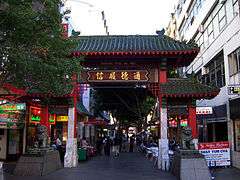 | |
| Total population | |
|---|---|
| 1,213,903 by ancestry (2016 census)[1] (5.6% of the Australian population)[2] 677,240 born in Mainland China (2019)[3] 101,290 born in Hong Kong (2019)[3] 59,250 born in Taiwan (2019)[3] 3,130 born in Macau (2019)[3] | |
| Regions with significant populations | |
| Sydney, Melbourne, Brisbane, Perth, Adelaide, Canberra, Newcastle, Gold Coast | |
| Languages | |
| Australian English Mandarin, Cantonese various other Chinese dialects | |
| Religion | |
| Chinese folk religion, Taoism, Confucianism; Irreligion, Christianity, Buddhism | |
| Related ethnic groups | |
| Chinese New Zealanders Hong Kong Australians Chinese Indonesians Malaysian Australians, Singaporean Australians, Overseas Chinese |
The early history of Chinese Australians involved significant immigration from villages of the Pearl River Delta in Southern China. Less well-known are the kinds of society Chinese Australians came from, the families they left behind and what their intentions were in migrating. Gold rushes lured many Chinese to the Australian colonies. (From the mid-19th century, Chinese dubbed Australia the New Gold Mountain after the Gold Mountain of California in North America.) They typically sent money to their families in the villages, regularly visited their families, and retired to their home villages after many years working as a market gardeners, shopkeepers or cabinet-makers. As with many overseas Chinese groups the world over, early Chinese immigrants to Australia established Chinatowns in several major cities, such as Sydney (Chinatown, Sydney), Melbourne (Chinatown, Melbourne, since the 1850s) and Brisbane (Chinatown, Brisbane), as well as in regional towns associated with the goldfields such as Cairns (Cairns Chinatown).[5]
History
Chinese peoples have a long and continuing role in Australian history. There were early links between China and Australia when Macau and Canton were used as an important trading ports with the fledgling colony. Mak Sai Ying (also known as John Shying) was the first officially recorded Chinese migrant in 1818. After his arrival he spent some time farming before, in 1829, he became prominent as the publican of The Lion in Parramatta. Early 19th Century migration was in limited numbers and sporadic, primarily those who came in this period were free merchants or adventurers and, the more common, indentured labourers.
.jpg)
The Australian Gold Rushes are what first lured thousands of Chinese to the country. In 1855 in Melbourne there were 11,493 Chinese arrivals.[6] This was startling considering that barely five years previous, Melbourne's entire population had only been around 25,000 people. Due to the widespread racist sentiments in parliament and on the goldfields, the first of many immigration restrictions and Chinese targeting laws was passed in late 1855. However, due to the long, poorly regulated borders between the colonies of Australia the numbers of Chinese on the goldfields continued to swell. Upon the goldfields Chinese peoples faced many hardships. There were violent anti-Chinese riots; the Buckland Riot, the Lambing Flats Riots, as well as general discrimination and prejudice. However, there were many establishments in this period that would have a lasting effect on the history of Australia and the history of Chinese in Australia. One of these establishments were the Chinese camps, which most often, later, became Chinatowns in Australia. There was also the establishment and the consolidation of power for Chinese societies, many of these are still active in Australia today. These societies provided support and community for the Chinese in the colonies.
After the gold rushes the numbers of Chinese living in the cities swelled and their businesses and industries contributed much to growth of Melbourne and Sydney in the late 19th century. Mei Quong Tart was a prominent business figure in Sydney. However, there were very few Chinese women migrating to Australia. At one point in the 1860s the numbers of Chinese in Australia was around 40,000. Of these, it is believed only 12, were women.[7] This gender imbalance meant that some Chinese men married women of European descent but many had it in their hearts to return to China.
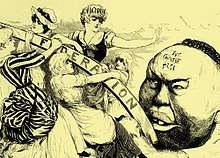
Anti-Chinese sentiment also strongly contributed to the establishment of the Federation of Australia. Some of the first Acts of the new federation would establish the White Australia Policy. This policy made it almost impossible for anyone new to migrate from China to Australia. After federation the population of Chinese in Australia steadily declined. Despite the declining numbers people with Chinese heritage still played their part in Australian history. There were over 200 people with Chinese heritage who fought for Australia in World War I, including the decorated sniper Billy Sing. A similar number fought for Australia in World War II.
The final end of the White Australia Policy from the 1960s saw new arrivals from the Chinese diaspora and for the first time significant numbers from non-Cantonese speaking parts of China. The first wave of arrivals were ethnic Chinese refugees from Vietnam and Cambodia during the 1970s. This was followed by economic migrants from Hong Kong and Taiwan in the 1980s and 1990s, whose families often settled in the capital cities. New institutions were established for these arrivals and old ones such as the Chinese Chamber of Commerce revived, while numerous Chinese language newspapers were once again published in the capital cities.
After the 1989 Tiananmen Square protests, then-Australian Prime Minister, Bob Hawke, allowed students from China to settle in Australia permanently. Since the 2000s, with the rapid development of China's economy, there has been an explosion in the number of immigrants from China, which have frequently been Australia's largest source of new immigrants since 2000. In 2015-16, China (excluding Hong Kong and Macau) was the second largest source of immigrants to Australia behind India.[8] China (excluding Hong Kong, Macau and Taiwan) is now the third largest foreign birthplace for Australian residents, after England and New Zealand.[9]
Demographics
| Year | Pop. | ±% p.a. |
|---|---|---|
| 1986 | 201,331 | — |
| 2001 | 556,554 | +7.01% |
| 2006 | 669,896 | +3.78% |
| 2011 | 866,205 | +5.27% |
| 2016 | 1,213,903 | +6.98% |
| Capital city[10][11][12][13][14][15] | Population (2016 census) | % |
|---|---|---|
| Sydney | 487,976 | 10.8 |
| Melbourne | 356,324 | 8.5 |
| Brisbane | 99,593 | 4.7 |
| Perth | 99,229 | 5.5 |
| Adelaide | 50,216 | 4.1 |
| Canberra | 22,445 | 6 |
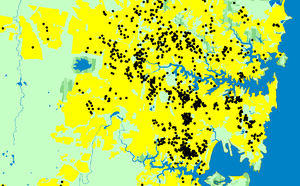
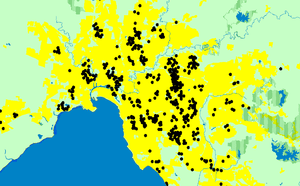
The White Australia Policy of the early 20th century severely curtailed the development of the Chinese communities in Australia. However, since the advent of multiculturalism as a government policy in the 1970s, many people of Chinese ethnicity from Asia (especially China, Indonesia, Malaysia, Singapore, Vietnam and Cambodia) have immigrated to Australia.
As a whole, Australian residents identifying themselves as having Chinese ancestry made up 5.6% of those nominating their ancestry at the 2016 census[4] and numbered 1,213,903.[1] At the 2016 census, 509,555 people declared that they were born in Mainland China,[1] 86,886 declared that they were born in Hong Kong,[1] while 46,882 declared that they were born in Taiwan. There are also a large number of persons of Chinese ancestry among those born in Southeast Asian countries such as Malaysia, Indonesia, Singapore, the Philippines and Vietnam.
Before the end of the 20th century, Chinese Australians were predominately of Cantonese and Hakka descent from Guangdong, Hong Kong and Macau, and Cantonese was the dominant language.[17] Due to more recent immigration from other regions of China, Mandarin has surpassed Cantonese by number of speakers. At the 2016 census, 596,711 persons declared that they spoke Mandarin at home (the most common language spoken at home in Australia after English at 2.5%),[4] followed by Cantonese at 280,943 (the third most common after English at 1.2%).[4] In total, there were 927,944 people who spoke a Chinese language at home,[4] a figure which includes Mandarin and languages such as Shanghainese, Cantonese, Hokkien and Hakka. Second or higher generation Chinese Australians are often either monolingual in English or bilingual to varying degrees with Chinese.
At the 2016 census, Sydney was home to 44% of the Mainland China-born population of Australia,[18] while Melbourne was home to 31%.[19] Brisbane had the largest Taiwanese-born population in the country.[20]
At the 2016 census, 487,976 (or 10.8%) of the inhabitants of Sydney who nominated their ancestry nominated Chinese ancestry solely or along with another ancestry.[21] In Melbourne, the number was 356,324 (or 8.5%), while in Brisbane it was 99,593 (or 4.7%) and in Perth it was 99,229 (5.5%).
In a 2004 study on the intermarriage pattern in Australia, the proportion of second-generation Chinese Australians with spouses of Anglo-Celtic ancestry was approximately 21% and for third generation it was 68%.[22]
According to Australian Bureau of Statistics, in 2012 Chinese immigrant mothers had a total fertility of 1.59 children per woman, lower compared to the Australian average of 1.94.[23]
Religion
According to the census data collected in the last twenty years, among Australians with full or partial Chinese ancestry there has been a general decline of institutional religions (between 2006 and 2016, Buddhism fell from 24.1% to 15.7% and Christianity fell from 29.8% to 23.4%). In 2016, 55.4% of the Chinese Australians fit within the census category of "not religious, secular beliefs or other spiritual beliefs", rising significantly from 37.8% in 2006. These shiftings in religious demography may be due to the incoming of new immigrants from China who generally do not have a formal religious affiliation, and many of whom are involved in the native Chinese religion (including Chinese ancestral worship) which has been on the rise in China over the last decades.
There are also several Chinese temples that exist and active in Australia, like Sarm Sung Goon Temple, Albion built in 1886, Heavenly Queen Temple (Melbourne) and Nan Tien Temple, a branch temple of Fo Guang Shan.
| Religion | 2006 | 2011 | 2016 | |||
|---|---|---|---|---|---|---|
| Number | % | Number | % | Number | % | |
| Not religious or Chinese religion | 238,678 | 37.8 | 359,139 | 43.7 | 633,056 | 55.4 |
| Christianity | 188,111 | 29.8 | 233,070 | 28.4 | 267,256 | 23.4 |
| Buddhism | 152,544 | 24.1 | 177,902 | 21.6 | 179,384 | 15.7 |
| Islam | 1,466 | 0.23 | 2,280 | 0.27 | 3,120 | 0.27 |
| Hinduism | 212 | 0.03 | 301 | 0.03 | 828 | 0.07 |
| Judaism | 139 | 0.02 | 170 | 0.02 | 219 | 0.02 |
| Other | 2,433 | 0.38 | 3,249 | 0.4 | 4,330 | 0.37 |
| Unclear | 2,375 | 0.37 | 3,423 | 0.4 | 2,883 | 0.25 |
| Unanswered | 44,643 | 7.0 | 41,074 | 5.0 | 50,364 | 4.4 |
| Total population | 630,598 | 100.0 | 820,613 | 100.0 | 1,141,440 | 100.0 |
Socioeconomics
Education
In 2006, 55.0 percent for Chinese-born Australians aged 15 years and over had some form of higher non-school qualifications compared to 52.5 percent of the Australian population. Among Chinese-born Australians, 42.2 percent had Diploma level or higher* qualifications and 4.8 percent had Certificate level qualifications. For Chinese-born Australians, 88,440 had no higher non-school qualification, of which 35.3 percent were still attending an educational institution.[25] In 2006, 57.3 per cent of the Hong Kong-born Australians aged 15 years and over had some form of higher non-school qualifications compared to 52.5 percent of the Australian population. Among the Hong Kong-born Australians, 45.7 per cent had Diploma level or higher qualifications and 6.1 percent had Certificate level qualifications. From the Hong Kong-born Australians, 28,720 had no higher non-school qualification, of which 44.7 per cent were still attending an educational institution.[26]
In 2006, 31.9% of Chinese Australians attained a bachelor's degree compared to just 14.8% for the general Australian population. 36.1% of Hong Kong Australians attained a bachelor's degree or higher. Chinese Australians born overseas reported high educational attainment with over 50% of them holding at least bachelor's degree.[27] When all these rates are melded, approximately 42 percent of (first and second generation) Chinese Australians have achieved a bachelor's degree, making it roughly three times the national average of 14 percent.[28]
The pathways Chinese-Australian families choose to motivate their children is partly based on their cultural values which emphasise scholastic excellence, and partly on their own experiences in their native as well as in the host country. Customarily, activities taking place in Chinese-Australian homes were related to the education of their children. Regular family discussions on educational matters and career paths had a modelling effect. The key feature of these families was that parental involvement in their children's school-related activities remained high throughout the high school time of their children. Chinese-Australian families indicated that diligence, a deep cultural respect for education and motivation to become educated was quite strong among first generation immigrants. Chinese-Australians have a significant influence and place considerable pressure on their children academically.[28][29][30] In addition, mathematics achievement and participation of high school students have a strong correlation towards the success or achievement goals and sense of competence.[31] In addition, Chinese students from migrant backgrounds, in comparison to those from refugee backgrounds, are more academically successful.[32]
Employment
Among Hong Kong-born Australians aged 15 years and over, the participation rate in the labour force was 63.3 percent and the unemployment rate was 6.6 percent. The corresponding rates in the total Australian population were 64.6 and 5.2 percent respectively. Of the 39,870 Hong Kong-born Australians who were employed, 42.2 percent were employed in a Skill Level 1 occupation, 12.3 percent in Skill Level 2 and 8.5 percent in Skill Level 3. The corresponding rates in the total Australian population were 28.7, 10.7 and 15.1 percent respectively.[26]
Many Chinese Australians work in white collar middle class jobs. But Chinese Australians are under-represented in occupations such as journalism, law and other professions that require language skills and face to face contact. First-generation Chinese Australians also experience problems in getting white collar jobs commensurate with their qualifications and work experience instead they go into business and operate convenience stores, car dealerships, grocery stores, coffee shops, news agencies and restaurants while sacrificing to pay for their children education as perceiving education as the only available channel of social mobility, substantial investment in their children's education at a disproportionate sacrifice to family finance and social well-being is an indication of parental concerns and expectations.[33][34]
33.8% of Chinese Australians and 46.6% Hong Kong Australians work as white collar professionals compared to 32% for the total Australian population. 63.3% of Hong Kong Australians and 56.3% of Chinese Australians participate in the Australian workforce which was below the national average of 67.1%. Chinese Australians and Hong Kong Australians also have an unemployment rate of 11.2% and 6.6% respectively. Both figures were higher than the national average of 4.9%.[35]
Economics
In 2006, the median individual weekly income for Chinese-born Australians aged 15 years and over was $242, compared with $431 for all overseas-born and $488 for all Australia-born. The total Australian population had a median individual weekly income of $466.[25] In 2006, the median individual weekly income for Hong Kong-born Australians aged 15 years and over was $425, compared with $431 for all overseas-born and $488 for all Australia-born. The total Australian population had a median individual weekly income of $466. Therefore, median weekly earnings for Chinese Australians are relatively lower than the population average.[26]
Notable Chinese Australians
There have been numerous notable Chinese Australians in various fields throughout Australia's history. Current Chinese-Australian federal Members of Parliament include Penny Wong, Ian Goodenough and Gladys Liu. Active Chinese-Australian athletes include Les Fong, Lin Jong, Cheltzie Lee, Melissa Wu, Cruze Ah-Nau, and Brendan Ah Chee.
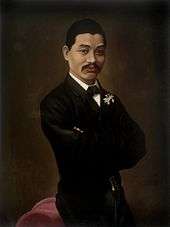 Mei Quong Tart (1850–1903), a prominent 19th-century merchant, socialite, and activist for Chinese-Australian rights based in Sydney.
Mei Quong Tart (1850–1903), a prominent 19th-century merchant, socialite, and activist for Chinese-Australian rights based in Sydney.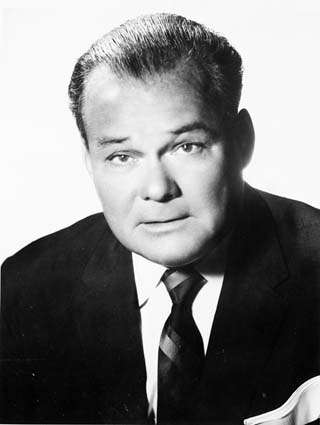 Sir Leslie Joseph Hooker (1903-1976), an Australian property entrepreneur, businessman and philanthropist and founder of, LJ Hooker.
Sir Leslie Joseph Hooker (1903-1976), an Australian property entrepreneur, businessman and philanthropist and founder of, LJ Hooker.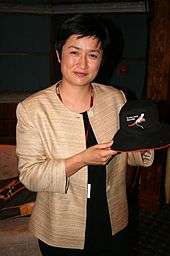 Penny Wong (1968-), an Australian politician who has been Senator for South Australia, Senate leader of the Australian Labor Party (ALP), and Leader of the Opposition in the Senate.
Penny Wong (1968-), an Australian politician who has been Senator for South Australia, Senate leader of the Australian Labor Party (ALP), and Leader of the Opposition in the Senate. Lin Jong (1993-), an Australian rules footballer who plays for the Western Bulldogs in the Australian Football League (AFL).
Lin Jong (1993-), an Australian rules footballer who plays for the Western Bulldogs in the Australian Football League (AFL).- Caleb Shang, (1884-1953; born Duckbour Caleb James Shang), a highly decorated Chinese Australian soldier who served in the First World War.
 Terence Tao (1975-), an Australian-American mathematician who has worked in various areas of mathematics and holds the James and Carol Collins Chair in mathematics at the UCLA.
Terence Tao (1975-), an Australian-American mathematician who has worked in various areas of mathematics and holds the James and Carol Collins Chair in mathematics at the UCLA.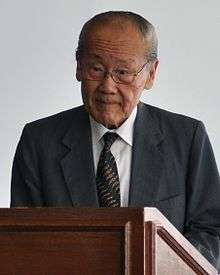 Wang Gungwu, (1930-), an Australian sinologist and Emeritus Professor of the Australian National University.
Wang Gungwu, (1930-), an Australian sinologist and Emeritus Professor of the Australian National University..jpg) Priscilla Hon (1998-), an Australian tennis player.
Priscilla Hon (1998-), an Australian tennis player..jpg) Cindy Pan, a general practitioner, television personality and author who specialises in sexual health and women's health.
Cindy Pan, a general practitioner, television personality and author who specialises in sexual health and women's health. Cheltzie Lee (1993), an Australian former competitive figure skater, 2010 national champion.
Cheltzie Lee (1993), an Australian former competitive figure skater, 2010 national champion.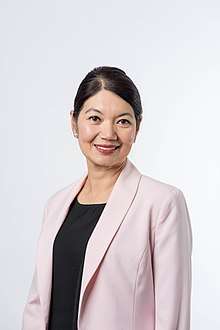 Jing Lee (1967-), a Malaysian-Australian politician of Chinese descent elected to the South Australian Legislative Council as a member of the Liberal Party.
Jing Lee (1967-), a Malaysian-Australian politician of Chinese descent elected to the South Australian Legislative Council as a member of the Liberal Party.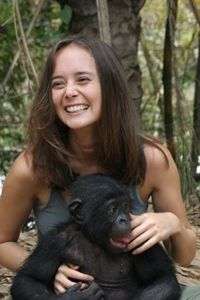 Vanessa Woods (1977-), an Australian science writer, author and journalist, and the main Australian/New Zealand feature writer for the Discovery Channel.
Vanessa Woods (1977-), an Australian science writer, author and journalist, and the main Australian/New Zealand feature writer for the Discovery Channel.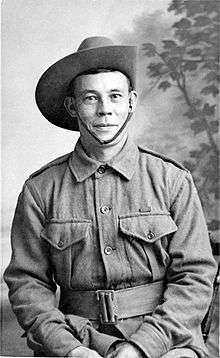 Billy Sing, (1886-1943), an Australian soldier of Chinese and English descent who served in the Australian Imperial Force during World War I.
Billy Sing, (1886-1943), an Australian soldier of Chinese and English descent who served in the Australian Imperial Force during World War I.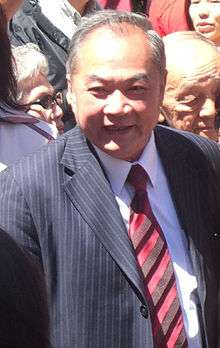
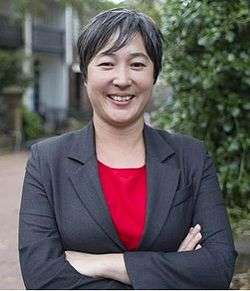 Jenny Leong (1977-), an Australian politician, member of the New South Wales Legislative Assembly representing Newtown for the Greens since 2015.
Jenny Leong (1977-), an Australian politician, member of the New South Wales Legislative Assembly representing Newtown for the Greens since 2015.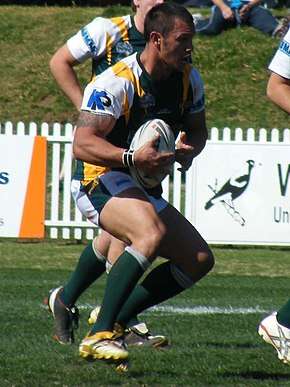 Jason Chan (1984-) is a former Papua New Guinea international rugby league footballer of Chinese descent.
Jason Chan (1984-) is a former Papua New Guinea international rugby league footballer of Chinese descent.
See also
- Asian Australians
- Australians in China
- China-Australia relations
- Chinatowns in Oceania
- Daigou#Australia
- History of Chinese Australians
- Jook-sing
References
- "2016 Census of Population and Housing". Censusdata.abs.gov.au. Retrieved 29 August 2017.
- Statistics, c=AU; o=Commonwealth of Australia; ou=Australian Bureau of (28 June 2017). "Main Features - Cultural Diversity Article". abs.gov.au.
- https://www.abs.gov.au/ausstats/subscriber.nsf/log?openagent&34120do005_201819.xls&3412.0&Data%20Cubes&B95CDCBDF3B53509CA25855700002DC2&0&2018-19&28.04.2020&Latest
- "Main Features - Cultural Diversity Article". Abs.gov.au. Retrieved 29 August 2017.
- "99 Grafton St (entry 602511)". Queensland Heritage Register. Queensland Heritage Council. Retrieved 7 July 2013.
- Jean Gittins.(1981). The Diggers From China: The Story of Chinese on the Goldfields. Quartet Books Australia. Melbourne. ISBN 0-908128-16-9. pg 128
- "Harvest of Endurance". Nma.gov.au. Retrieved 29 August 2017.
- "2015–16 Migration Programme Report : Programme year to 30 June 2016" (PDF). Border.gov.au. Archived from the original (PDF) on 18 August 2017. Retrieved 29 August 2017.
- http://www.abs.gov.au/ausstats/abs@.nsf/Latestproducts/3412.0Main%20Features22017-18?opendocument&tabname=Summary&prodno=3412.0&issue=2017-18&num=&view=
- "Data". censusdata.abs.gov.au.
- "Data". censusdata.abs.gov.au.
- "Data". censusdata.abs.gov.au.
- "Data". censusdata.abs.gov.au.
- "2016 Census Community Profiles: Greater Adelaide". quickstats.censusdata.abs.gov.au.
- "2016 Census Community Profiles: Australian Capital Territory". quickstats.censusdata.abs.gov.au.
- The Australian Bureau of Statistics publishes this data as being a count of people born in "China (excludes SARs and Republic of China (Taiwan))"
- Jakubowicz, Andrew. "What's the 'ethnic vote' going to do in Australia's top-ten ethnic marginal seats?". Theconversation.com. Retrieved 29 August 2017.
- "2016 Census QuickStats: Greater Sydney". Censusdata.abs.gov.au. Retrieved 29 August 2017.
- "2016 Census QuickStats: Greater Melbourne". Censusdata.abs.gov.au. Retrieved 29 August 2017.
- "General Community Profile". Censusdata.abs.gov.au. Retrieved 29 August 2017.
- "General Community Profile". Censusdata.abs.gov.au. Retrieved 29 August 2017.
- Lucille Lok-Sun Ngan, Chan Kwok-bun, The Chinese Face in Australia Multi-generational Ethnicity among Australian-born Chinese, 2012, p. 155
- "Details - Contents". Abs.gov.au. Retrieved 29 August 2017.
- Australian Bureau of Statistics. "Census Table Builder". Retrieved 10 January 2018.
- Government, Australia. "China-born" (PDF). Australian Government. Archived from the original (PDF) on 25 March 2012. Retrieved 5 May 2012.
- Government, Australian. "Hong Kong-born" (PDF). Australian Government. Archived from the original (PDF) on 30 March 2012. Retrieved 5 May 2012.
- Laurence J. C. Ma; Carolyn L. Cartier (2003). The Chinese Diaspora: Space, Place, Mobility, and Identity. Rowman & Littlefield. p. 369. ISBN 978-0-7425-1756-1.
- Leung, Kwok. "Parenting Styles and Academic Achievement: A Cross-Cultural Study". Merrill-Palmer.
- "The Dragon Children". The Dragon Children. Retrieved 5 May 2012.
- Stevenson, Andrew. "Chinese parents taught to prize all-rounders". The Sydney Morning Herald. Retrieved 13 September 2010.
- OTSUKA, SETSUO. "CULTURAL INFLUENCES ON ACADEMIC ACHIEVEMENT IN FIJI" (PDF). University of Sydney. Archived from the original (PDF) on 15 September 2012. Retrieved 5 May 2012.
- Fan, Cynthia. "THE MATHEMATICS ACHIEVEMENT AND ASPIRATIONS OF CHINESE-AUSTRALIAN GIRLS AND ANGLO-AUSTRALIAN GIRLS IN AUSTRALIA". Victoria University. Archived from the original on 9 January 2012. Retrieved 5 May 2012.
- Ranbir, Malik. "The Shirk-work Ethic in High School: Vegefication of Anglo-Australian Students" (PDF). Edith Cowan University.
- "3416.0 – Perspectives on Migrants, 2008". Abs.gov.au. Retrieved 5 May 2012.
- "The People of Australia 2006 Census" (PDF). Commonwealth of Australia. Archived from the original (PDF) on 4 December 2010. Retrieved 5 May 2012.
Further reading
- Brawley, Sean, The White Peril – Foreign Relations and Asian Immigration to Australasia and North America 1919–1978, UNSW Press, Sydney, 1995. 9780868402789
- Cushman, J.W., "A 'Colonial Casualty': The Chinese community in Australian Historiography", Asian Studies Association of Australia, vol.7, no 3, April 1984.
- Fitzgerald, Shirley, Red Tape, Gold Scissors, State Library of NSW Press, Sydney, 1997.
- Macgregor, Paul (ed.), Histories of the Chinese in Australasia and the South Pacific, Museum of Chinese Australian History, Melbourne,1995.
- May, Cathie, Topsawyers: the Chinese in Cairns 1870 to 1920, James Cook University, Townsville, 1984.
- Williams, Michael, 2018, Returning home with glory: Chinese villagers around the Pacific, 1849 to 1949 (榮歸故里:太平洋地區的中國僑鄉 1849–1949), Hong Kong University Press, Hong Kong.
- Taylor, Antony. "Chinese Emigration to Australia around 1900: A Re-examination of Australia’s 'Great White Walls'" History Compass (Feb. 2013) 11#2 pp 104–116, DOI:10.1111/hic3.12032
- Williams, Michael, Chinese Settlement in NSW – A thematic history (Sydney: Heritage Office of NSW, 1999) www
.heritage .nsw .gov .au
External links
- Chinese Museum Chinese Immigration to Australia
- Chinese-Australian Historical Images in Australia
- Chinese Australian Historical Society
- From Quong Tarts to Victor Changs: Being Chinese in Australia in the Twentieth Century
- [http The Poison of Polygamy - the first Chinese Australian novel://chineseaustralianhistory.org Chinese Australian history website]
- Tracking The Dragon – A history of the Chinese in the Riverina online exhibition
- Tracking the Dragon A guide for finding and assessing Chinese Australian heritage places
- The Harvest of Endurance scroll – an interactive representing two centuries of Chinese contact with, and emigration to, Australia at the National Museum of Australia
- Culture Victoria – Dreams of Jade and Gold – Chinese Australian families
- Chinese Language Records at Public Record Office Victoria
- The tiger’s mouth – Thoughts on the history and heritage of Chinese Australia
- Shirley Fitzgerald - City of Sydney History Unit (2008). "Chinese". Dictionary of Sydney. Retrieved 4 October 2015. (Chinese in Sydney) [CC-By-SA]
- Chinese Australian History in 88 Objects
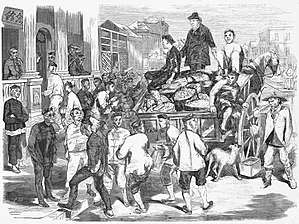
.jpg)